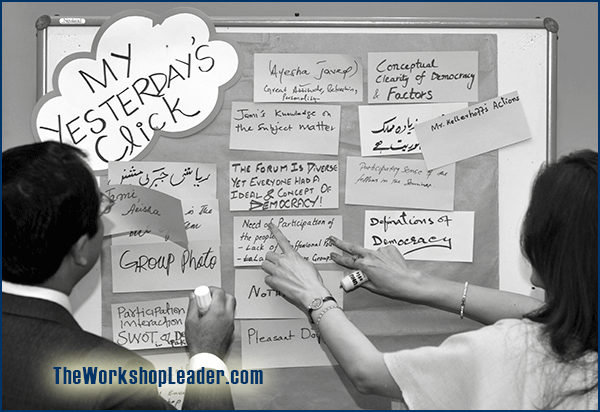Learn from yesterday, live for today, hope for tomorrow. The important thing is not to stop questioning.
Albert Einstein (1879–1955)
German theoretical physicist

Repetitio mater studiorum est – as the Latin phrase goes: repetition is the mother of learning. So it is important that on the second or third day of a workshop, the group recollects the memories of the previous day. This is good not just for the participants but also gives you an excellent idea of what participants have retained, what they understood and how they rate their learning.
Furthermore, it refocuses the group after all the evening activities, private phone calls, breakfast and sports that have taken place since the end of the previous day’s seminar. Using ‘Yesterday’s Click’ allows the group to revisit the previous day’s major points.
The name comes from the sound of a camera. It freezes one situation the participants has in mind. Like a photo represents a whole souvenir of an event, this shot reflects the whole previous workshop day. For the same reason another name for this short exercise is Flashlight – as the flash of a camera freezes a specific moment, which stands for the whole event.
Forms of Yesterday’s Click
You can either ask quickly one by one, or have cards filled out which will be used to stimulate brief discussions about the topics.
Verbal
For the verbal form just go one participant by the other. He or she should shoot out the topic or situation, which pops up in his mind as the most striking, most retainable, most important.
It is recommended not to go just from one direction because the last fews relax and are not fully present. The aim of refocus of the whole group would not be achieved. Rather jump randomly. Make sure not to forget someone.
Cards
As an alternative you can hand out cards and markers. Participants then write their most important or most striking learning from the previous day. This takes a little more time (10–20 min incl. debriefing). Simultaneously, participants exercise the handling with cards and the distillation process of reducing content to one or two words. Take an assistant to stick or glue the cards, which is an exercise for working with the board at the same time.
A picture of the collection helps you with your photo protocol.
Sketches
More creative, fun and interesting are sketches. Participants need to transfer their experience into design. This supports the learning process even more. But it also requires more time: first for the sketches, second for the explanation and clarification during the debriefing. However, it could be worth it.
For your photo protocol this would be the even nicer variation for illustration.

